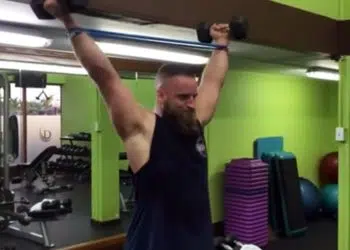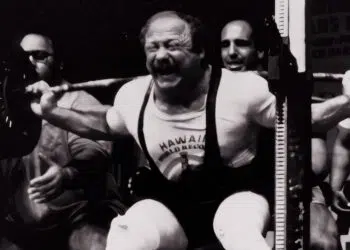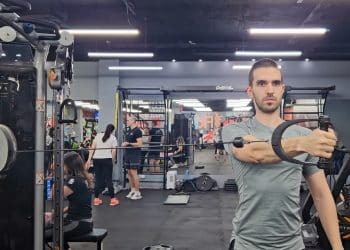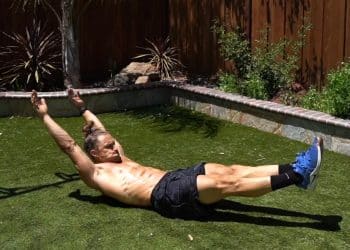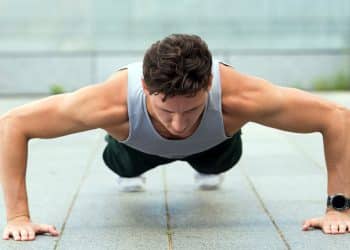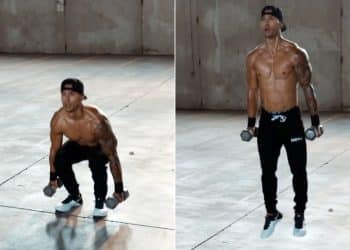A favorite of bodybuilding legend Arnold Schwarzenegger back in the day, weighted bench dips are just as effective and relevant decades later. Whether you desire more upper arm mass, better triceps tone and definition, or building up your pressing strength, the benefits of this bodyweight compound movement cannot be ignored.
However, we recommend this exercise for those who’ve already mastered the basic bodyweight bench dip. Most people perform bench dips incorrectly, putting their shoulder health at risk, and limiting triceps activation. It defeats the purpose of using such a powerful exercise.
This guide will show you how to accomplish the perfect bench dip, plus we talk about the benefits, weighted bench vs hanging dips, the most common form mistakes, and the best-weighted bench dip variations and alternatives.
Muscles Worked During Weighted Bench Dips
Weighted bench dips are a powerful push-based movement that works several upper body muscles. Learn about their anatomy and function below.
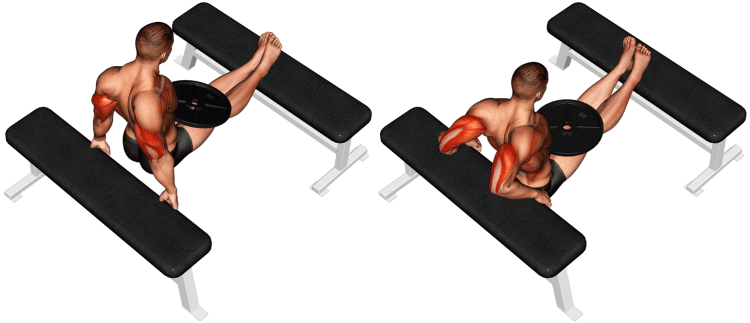
Triceps brachii
Big arms are mostly the result of well-developed triceps muscles. That’s because, compared to the biceps that has just two heads, your triceps have three (lateral, middle and long)!
Triceps muscles are on the back of the upper arm between the elbow and shoulder where it crosses both joints. Consequently, triceps straighten the arm at the elbow and the long head plays a small role at the shoulder (extending the arm back behind the body to perform triceps kickbacks).
Level Up Your Fitness: Join our 💪 strong community in Fitness Volt Newsletter. Get daily inspiration, expert-backed workouts, nutrition tips, the latest in strength sports, and the support you need to reach your goals. Subscribe for free!
Deltoid Anterior
While the goal is to minimize shoulder involvement, the anterior or front deltoids contract when the arm transitions from a bent to extended position. So the front delts will get a little engagement which is fine.
Latissimus Dorsi
Lats are a major back muscle taking up a large portion of the upper posterior. They are active when the arms pull the torso forward and up like during pull-ups.
Levator Scapulae
The levator scapulae are back muscles that function to raise the shoulder blades (scapula).
Pectoralis Major Sternal Head
While the chest is not the focus during bench dips, its involvement is a byproduct of the movement. The lower or sternal fibers, in particular, activate best when the arms are brought downward.
Pectoralis Major Clavicular Head
Every press activates all sections of the chest including the upper or clavicular portion of fibers. A more chest focused dip will add more stimulus to the pec muscles.
Benefits of Weighted Bench Dips
We can think of several reasons to include weighted bench dips in your triceps exercise rotation.
Great alternative to captain’s chair dips
Captain’s chair dips are a whole other animal, and not really the best choice for beginners or overweight individuals. Instead, bench dips still allow you to replicate a dip but they’re more practical, easier to regress, more versatile and you can do them anywhere, even without a bench.
Not to mention, they’re less intimidating. Anyone can do them with correct form and benefit from a compound triceps movement.
Build triceps strength
The triceps are involved in every press-focused exercise or activity. The stronger they are, the better your performance, whether you want to lift more on the bench press, or be more competitive in the sports arena.
Better arm aesthetics
The biceps may be more popular but the triceps are, anatomically, bigger and stronger. It’s silly to not give the triceps as much, if not more attention than the biceps.
Dips are widely regarded as one of the top triceps and push muscle movements, in general. If you challenge yourself by adding more reps or weight to your bench dips, your triceps will sprout new gains.
Do them at home
You don’t need a gym to do weighted bench dips. In fact, you don’t even need a bench. A chair, or object of similar height and sturdiness will do just fine. Then, if you don’t have weight plates you can use a dumbbell, bands, or anything that you can place on your lap that will add equal resistance.
How To Do Weighted Bench Dips
Weighted bench dips can either be one of the best movements in your arm day arsenal, or a pain in your delts. Bad form will place unnecessary stress on your shoulders and the movement will feel subpar at best.
We’re going to show you the right way to perform weighted bench dips with detailed step-by-step instructions, a video example and key technique tips.
Exercise steps
Learn how to perform weighted bench dips in just a few simple steps.
Step 1
Sit in the center on the long side of a bench. Place both hands fully on the bench close to your butt on either side and point your fingers outward laterally away from your body. This will externally rotate or turn the shoulder outward, which is safer and healthier for the shoulder structure.
Step 2
Move your butt forward off the bench a few inches from the edges to give yourself space to dip down.
Step 3
Next, you’ll need to determine how to position your legs. Here are a few options.
- Place both feet on the floor roughly hip width apart and knees bent at a 90-degree angle. Easier to get the weight in position.
Or
- Elevate your feet on a bench or object similar in height with both legs fully extended. Better with a partner’s assistance.
Step 4
Place the weight on your lap a few inches from your hips, or have your partner do it for you. It’s okay if the weight sits over top of your knee.
Pro tip: Use a rubber-coated plate.
Step 5
Lean your upper body back at a slight angle (not fully upright), then pull your shoulders back and down.
Level Up Your Fitness: Join our 💪 strong community in Fitness Volt Newsletter. Get daily inspiration, expert-backed workouts, nutrition tips, the latest in strength sports, and the support you need to reach your goals. Subscribe for free!
Step 6
Slowly bend your elbows and dip down, then stop before your upper arms are parallel to the floor. Now straighten both arms and use your triceps muscles to push yourself up. Fully extend the arms and squeeze your triceps hard at the top.
You should notice that the exercise is harder than how most people normally perform the movement. That’s because you’re using more triceps and that’s the point!
Video tutorial
We really like the following video demonstration of a more improved and safer version of bench dips. Note: The tutorial does not demonstrate the weighted bench dip. However, most examples do not address the risk of shoulder issues using the conventional bench dip technique.
Tips
- Keep your butt close to the bench, a few inches from the edge but not too far forward.
- Do not allow your head to sink down into your shoulders. Keep your scapula down during the movement.
- You don’t need to dip down very far to get a good triceps workout. Stop before the upper arms are parallel to the floor to protect the shoulders.
- If loading more than one plate, do a few reps to ensure it’s secure and comfortable on your lap before adding more.
- Use a spotter to help put the weight on your lap, if possible.
This Exercise:
- Target Muscle Group: Triceps brachii
- Secondary Muscles: Deltoid Anterior, Latissimus Dorsi, Levator Scapulae, Pectoralis Major Clavicular Head, and Pectoralis Major Sternal Head
- Type: Hypertrophy and strength
- Mechanics: Compound
- Equipment: Bench and weights
- Difficulty: Intermediate/advanced
- Best Rep Range:
- Hypertrophy: 8-12
- Strength: 4-5
- Hypertrophy and endurance: 15+ reps
Common Mistakes While Performing Weighted Bench Dips
Sometimes mistakes are forgivable. However, you don’t want to take any chances when your shoulders are involved. Avoid these bad habits when performing weighted bench dips.
Moving your body too far away from your arms
Creating too much space between your arms and butt may be the worst dipping mistake you can make. The delts are weaker and less supported in this position and adding more load to the movement will exacerbate this. Again, try to keep your body relatively close to the bench but leave enough room so that you can drop to the desired depth.
Dropping too far down
We explained that it’s not necessary to descend too far down. This will allow other muscles to take over and can unnecessarily stress the deltoids. Stop the dip before your arms are 90 degrees.
Working your chest and delts
Because dips are a multi-joint, compound push muscle exercise, the chest and front delts are assisting muscle groups. There’s no way to remove them from being involved. But you want to avoid leaning your torso forward which will shift more emphasis onto these muscles.
While dips can be a useful chest exercise, it’s best done using a captain’s chair (bench dips are best for triceps focus) or machine which are variations you’ll find below.
Read: Chest Dips vs. Triceps Dips – What’s the Difference?
Not carefully loading the plates
Stacking weights on your legs… hmm, what could possibly go wrong? A whole lot if you do it wrong, or you’re not on the same page with the person assisting you.
Make sure the weight is even on your lap, and do a few reps with one plate before stacking more on top.
One cringe mistake you really have to be careful of is stacking one plate on top of the other and pinching your belly in between (It happened to me before and it’s not fun).
5 Variations and Alternatives of Weighted Bench Dips
Every dip variation has its place and advantages over the others.
1. Bodyweight-only bench dips
Weighted dips are a great way to build your pressing power. However, they require more setup time and sometimes, they aren’t necessary.
If you’re doing basic bodyweight bench dips per the exercise instructions included in this guide, most people will find that they’re more than challenging. But yet many will jump ahead to the weighted variation, compensating with bad form to get the lockout at the top.
Try to do 15 good bodyweight only dips with good form. If you can, then consider adding a little more resistance.
Steps
- Sit in the center on the long side of a bench with your butt near the edge.
- Place your hands fully on the bench on either side of your butt and point your fingers out laterally away from your body.
- Scoot your butt forward off the bench a few inches from the edge. Keep your feet on the floor roughly hip width apart and legs bent at a 90-degree angle or extend both legs and place your heels on the floor.
- Pull your shoulders back and down.
- Bend your elbows and dip down bearing the weight of your body on the triceps muscles. Stop before the upper arms are parallel to the ground.
- Use your triceps to push until both arms are fully extended. Squeeze hard at the top and repeat.
Note: Use the video example in this guide to see a proper demonstration of bench dips.
2. One-arm bench dip
An alternative to adding a weight plate to bench dips is to do it using one arm. Single limb exercises are always more challenging because, well, you don’t have as much strength. One arm dips should only be utilized by more advanced exercisers. Because if done incorrectly. it could be especially dangerous for the shoulders.
3. Captain’s chair/power tower dips
Considered the standard for bodyweight dips, the captain’s chair or power tower variation has some notable advantages over bench dips.
With a captain’s chair setup, there’s no bench, therefore, your shoulders are in a safer position, close to your sides. It’s also the most convenient option for adding the most weight to a bodyweight dip. You can use a dipping belt and safely add plates to your heart’s content without needing any assistance.
However, power tower dips are more challenging than the bench version by default. So, start with just your body weight and then determine if you should add more resistance.
One Rep Max Triceps Dips Calculator
4. Machine dips
Of course, you can never go wrong with a good old machine dip. Instead of lifting yourself, you’re pushing against a preselected weight. And that’s the major advantage of machine dips. Beginners and more overweight exercisers can still get the benefits of dips.
Steps
- First, sit on the machine and adjust the seat height so that when you grip the handles, your upper arms are slightly below parallel to the floor and not at a 90-degree angle.
- Choose your weight. Do a practice rep to determine if the resistance is appropriate.
- Grip the handles near the ends strong in your palms and keep your wrists straight. Your elbows should be back and now flared out wide.
- Maintaining an upright posture or very slight lean forward, push down with your palms until your arms are full extended. Squeeze your triceps hard for one second and repeat the exercise as many times as needed.
Tips
- Always rotate the handles inward to a more narrow grip. The wide grip will activate more of the chest muscles.
- Do not flare your elbows out wide as this will also engage more of the chest muscles.
- Utilize the seatbelt to hold yourself down, if necessary.
- Try to keep the shoulders and traps relaxed.
- Avoid bending the elbows too far. The arms should not bend past a 90-degree angle.
5. Dip assist machine modification
This one is essentially a standing, reverse bench dip. But you hardly see anyone talk about or recommend this exercise. However, it feels absolutely amazing! Just make sure no one is around because you may get a bad look if you use a machine for anything other than its intended purpose.
Steps
- Choose a light to moderate weight on the machine.
- Face away from the dip assist machine and place your hands on the padded platform (the one you usually kneel on with your shins) roughly shoulder width apart or slightly closer together. Bend your knees slightly before or during the first rep when you push down on the platform.
- While maintaining an upright torso, push the assist platform down until your arms are fully extended and squeeze for a second or two.
- Bend your elbows and stop before the upper arms are parallel to the floor, then repeat for the desired number of repetitions.
Note: We could not find a suitable video example for this variation. Try your best to imagine and replicate the movement.
Frequently Asked Questions
Are weighted bench dips safe for the shoulders?
If you perform weighted bench dips with proper technique as demonstrated in this exercise guide, you will minimize shoulder risk and stimulate mass growth in your triceps.
Are bench dips better than hanging dips?
Each has its advantages and disadvantages. Bench dips are better for beginner and overweight exercisers while hanging dips are more advanced.
Who should not do weighted triceps dips?
While anyone can do weighted triceps dips, we don’t recommend them for absolute beginners, overweight lifters, and those with pre existing shoulder issues.
A better option is dips using just the body weight as resistance and no additional weight.
Wrapping Up
The weighted bench dip isn’t for the novice, but once you can master a bodyweight only bench dip, adding weight is a sure way to continue making triceps gains! While it has some drawbacks, a properly performed bench dip is a versatile, convenient mass and strength builder that has advantages over its counterparts.
This guide was designed to help explain and demonstrate safe and effective execution of bench dips. It should be a helpful resource for anyone who wants to get the most out of this effective exercise.
Interested in measuring your progress? Check out our strength standards for Bench Press, Pull Ups, Bench Dips, and more.


